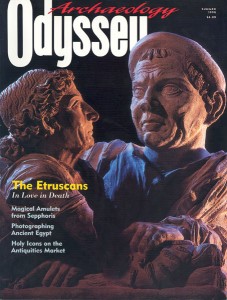How the Etruscans Influenced Western Art
Sidebar to: The Etruscans
The distinctive qualities of Etruscan painting, sculpture and metalwork have provided continuous inspiration for artists of later periods.
One of the 13th century’s greatest artistic triumphs, the Gothic Baptistery at Pisa, shows an unmistakable Etruscan touch: The sculpted heads that adorn the filigreed arcades of its facade recall the arched opening of an Etruscan gate in nearby Volterra, which still sports the battered stone heads of three figures, possibly divine guardians of the city.
Similarly, huge stone creatures—a lion and a sea monster—crouch along the roofline of a ninth-century Romanesque church in Viterbo, just as life-size sculptures of humans and beasts once studded the ridgepoles of Etruscan temples.
In the 15th and 16th centuries, Renaissance sculptors like Antonio del Pollaiuolo and Michelangelo paid close attention to small bronze Etruscan statues that farmers wrested from the Tuscan soil and sold to collectors. The liveliness of Etruscan modeling shaped important aspects of the Florentine sculptural style, from the springy elasticity and wiry physiques of Pollaiuolo’s small bronzes to the edgy alertness of Michelangelo’s grand marble David.
Images of the Virgin Mary—like Nicola Pisano’s gracefully reclining medieval relief in Pisa or Michelangelo’s fully Renaissance Madonna in Bruges, Belgium—clearly resemble the women on Etruscan cinerary urns, such as those from the old Medici collection now housed in the Florence Archaeological Museum.
Already a library member? Log in here.
Institution user? Log in with your IP address.

